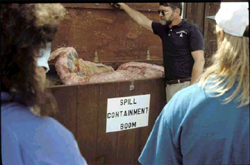New York Sea Grant's
Marina Pollution Prevention Web Site
Section 6: Emergency Planning
Potential Environmental Impacts
Being adequately prepared for emergency action can  potentially
reduce the overall environmental impact of a spill, fire or other
event.
potentially
reduce the overall environmental impact of a spill, fire or other
event.
Best Management
Practices
Assess potential
hazards at your facility, both manmade (fuel spill or fire) and
natural (nor'easter or hurricane).
Develop an
oil spill contingency plan, even if you are not required by law
to prepare an Spill Prevention and Control Countermeasures (SPCC)
Plan (see Regulatory Issues section below). Such plans should
identify potential spill sources, oil and hazardous materials
used or stored in the area, spill prevention measures (e.g., security,
inspection, containment, training, equipment), and spill emergency
procedures, including contact information of marina personnel
qualified to lead spill response efforts, notification, and spill
containment measures.
Store spill
containment and control materials in a clearly marked location,
readily accessible to work and storage areas. These spill response
kits should include absorbent pads and booms, empty sandbags,
sewer pipe plugs, drain covers, fire extinguishers, and a copy
of the facility's spill contingency plan.
- Develop
emergency response plans that include written procedures for
action addressing potential emergency situations. Keep the plan
in an accessible location. A spill contingency plan and emergency
response plan can be combined into one document. Emergency response
plans should:
- Include
a site plan of the facility, showing valves, pipes, tanks, structures,
roads, hydrants, docks, power and fuel shutoffs, hazardous material
storage locations, telephones, and location of emergency response
materials.
- Describe
the type, amount, and location of hazardous and potentially
hazardous materials stored on-site.
- Identify
which staff member will take what action in the event of an
emergency.
- Designate
one person as the spokesperson for the marina.
- Include
a list of emergency phone numbers for:
- USCG
National Response Center (800) 424-8802 (for spills)
- State
Spill Response [In New York (800) 457 7362
- Local
fire and police
- Facility
owner
- Local
harbormaster
- Neighboring
marinas that have emergency response equipment
- Spill
response contractors
- List and
describe actions to be taken during an emergency and, based
on likely threats, what equipment should be deployed.
- Indicate
when additional resources should be called for assistance.
- Update
the emergency response plan as necessary each year.
- Review
the emergency response plan with employees, and train them on
proper use of containment material.
Contact local
emergency response providers or local U.S. Coast Guard Marine
Safety Office to obtain basic information about how to handle
emergencies and/or for training opportunities.
Inform local
fire department and harbormaster of your emergency response plan.
Develop an
action checklist for severe weather. Preparations to reduce environmental
risks include securing all dumpsters, removing or securing all
objects which could potentially blow or wash away, and securing
waterside sewage pumpouts and/or dump stations.
Regulatory
Issues
If your facility
stores gas or oil 1) above-ground in any size tank(s) with a total
aggregate volume over 1,320 gallons (containers of less than 55
gallons and/or permanently closed storage tanks are exempt from
the total); or 2) in underground storage tanks with total capacity
greater than 42,000 gallons (unless the tanks are compliant with
the state requirement for USTs), you need to prepare a Spill,
Prevention, Control, and Countermeasure (SPCC) Plan, which outlines
a facility-wide plan to prevent and clean up oil and gasoline
spills [40 CFR 112, click
here]. For more information on the federal program
for marinas, click
here). For a sample SPCC plan, click
here.
If your facility
is a Large Quantity Generator of hazardous waste, you must prepare
a hazardous waste contingency plan. For more information on New
York's Hazardous Waste Regulations and compliance requirements
for marinas, click
here.
If you have
a marine service station, you must design and manage it to prevent
spills, fire and other dangers as required in the National Fire
Protection Association's (NFPA) Automotive and Marine Service
Station Code (NFPA 30A). (To view a copy of this section of
the code on-line at the NFPA Web site, click
here.) These requirements are adopted locally.
Check with your municipal fire marshal for local requirements,
or contact the State Fire Marshall's Office. (In New York call
(518) 474-6746 or e-mail at fire@dos.state.ny.us).
If you store
hazardous materials in quantities above certain threshold amounts,
you must report storage of that substance under the Emergency
Planning and Community Right-to-Know Act of 1986 (EPCRA) [40
CFR 355, click
here]. For more information on EPCRA requirements,
click
here.
Keep copies
of Material Safety Data Sheets (MSDS) for all hazardous substances
used at your facility [Occupational Safety and Health Act of 1970,
29 USC Section 657].
In case of
a spill of oil, petroleum, chemical liquids or solids, liquid,
gaseous products or hazardous waste, report the spill to your
state spill response division. [In New York, call the NYSDEC Spill
Response Unit at (800) 457 7362] For more information on spill
response requirements, click
here.
If any fuel
that is spilled into navigable waters causes a visible sheen,
it may be necessary to report that spill to the National Response
Center at (800) 424-8802 [Section 311 of the Clean Water Act;
33 USC 1321].

 potentially
reduce the overall environmental impact of a spill, fire or other
event.
potentially
reduce the overall environmental impact of a spill, fire or other
event.